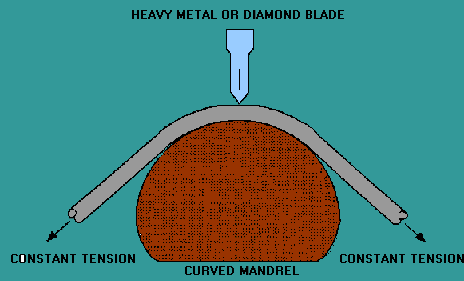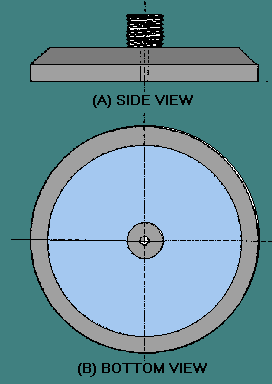FIBER END PREPARATION
In fiber-to-fiber connections, a source of extrinsic coupling loss is poor fiber end
preparation. An optical fiber-end face must be flat, smooth, and perpendicular to the
fiber's axis to ensure proper fiber connection. Light is reflected or scattered at the
connection interface unless the connecting fiber end faces are properly prepared. Figure
4-5 shows some common examples of poor fiber ends. It illustrates a fiber-end face tilt,
lip, and hackle. Quality fiber-end preparation is essential for proper system
operation.
Figure 4-5. - Poor fiber-end preparation.

Fiber-end preparation begins by removing the fiber buffer and coating material from the
end of the optical fiber. Removal of these materials involves the use of mechanical
strippers or chemical solvents. When using chemical solvents, the removal process must be
performed in a well-ventilated area. For this reason mechanical strippers are used for
buffer and coating removal in the shipboard environment. After removing the buffer and
coating material, the surface of the bare fiber is wiped clean using a wiping tissue. The
wiping tissue must be wet with isopropyl alcohol before wiping.
The next step in fiber-end preparation involves cleaving the fiber end to produce a
smooth, flat fiber-end face. The score-and-break, or scribe-and-break, method is
the basic fiber cleaving technique for preparing optical fibers for coupling. The
score-and-break method consists of lightly scoring (nicking) the outer surface of the
optical fiber and then placing it under tension until it breaks. A heavy metal or diamond
blade is used to score the fiber. Once the scoring process is complete, fiber tension is
increased until the fiber breaks. The fiber is placed under tension either by pulling on
the fiber or by bending the fiber over a curved surface.
Figure 4-6 shows the setup for the score-and-break procedure for fiber cleaving. Under
constant tension, the score-and-break method for cleaving fibers produces a quality fiber
end. This fiber end is good enough to use for some splicing techniques. However,
additional fiber-end preparation is necessary to produce reliable low-loss connections
when using fiber optic connectors.
Figure 4-6. - Score-and-break procedure for fiber cleaving.

Polishing the fiber ends removes most surface imperfections introduced by the fiber
cleaving process. Fiber polishing begins by inserting the cleaved fiber into the ferrule
of a connector assembly. A ferrule is a fixture, generally a rigid tube, used to hold the
stripped end of an optical fiber in a fiber optic connector. An individual fiber is
epoxied within the ferrule. The connector with the optical fiber cemented within the
ferrule can then be mounted into a special polishing tool for polishing.
Figure 4-7 shows one type of fiber polishing tool for finishing optical fibers in a
connector assembly. Various types of connector assemblies are discussed later in this
chapter. In this type of polishing tool, the connector assembly is threaded onto the
polishing tool. The connector ferrule passes through the center of the tool allowing the
fiber-end face to extend below the tool's circular, flat bottom. The optical fiber is now
ready for polishing.
Figure 4-7. - Fiber polishing tool.

Fiber polishing involves a step-down approach. The first step is to give the surface of
the fiber end a rough polish. Rough-polishing occurs when the fiber, mounted to the
polishing tool, moves over a 5μ to 15μ grit abrasive paper. The mounted
fiber moves over the abrasive paper in a figure-eight motion. The next step involves
giving the surface of the fiber end a fine polish. Fine-polishing occurs when the
mounted fiber moves over a 0.3μ to 1μ grit abrasive paper in the same
figure-eight motion. Fiber inspection and cleanliness are important during each step of
fiber polishing. Fiber inspection is done visually by the use of a standard microscope at
200 to 400 times magnification.
A standard microscope can be used to determine if the fiber-end face is flat, concave,
or convex. If different parts of the fiber-end face have different focus points, the end
face is not flat. If all parts of the fiber-end face are in focus at the same time, the
end face is flat.
Q.11 Quality fiber-end preparation is essential for proper system operation. What
properties must an optical fiber-end face have to ensure proper fiber connection?
Q.12 What is the basic fiber cleaving technique for preparing optical fibers for coupling?
Q.13 Using a standard microscope to inspect a fiber-end face, you observe that all parts
of the fiber-end face are in focus at the same time. Is the fiber-end face flat, concave,
or convex?







